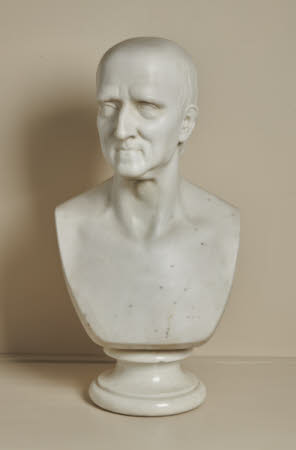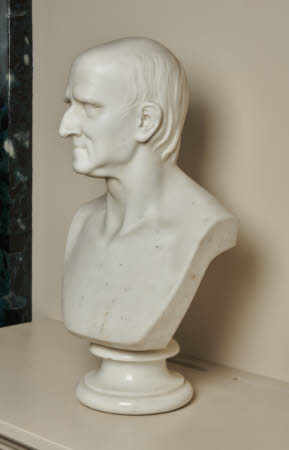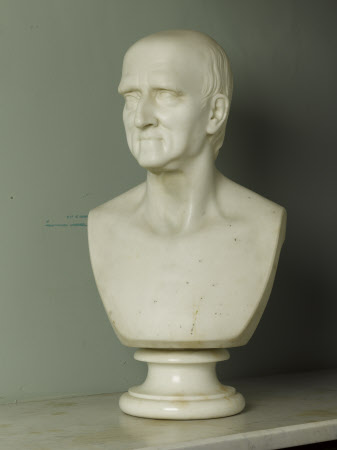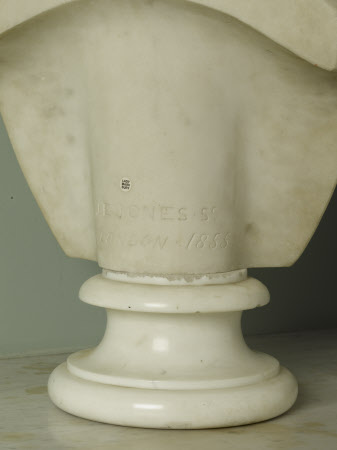Portrait bust of Charles Vane, 3rd Marquess of Londonderry (1778-1854)
John Edward Jones (Dublin 1806 - Finglas 1862)
Category
Art / Sculpture
Date
1855 (signed and dated) - 1862 (exh at RA)
Materials
Marble
Measurements
700 x 370 x 285 mm
Place of origin
London
Order this imageCollection
Mount Stewart, County Down
NT 1220127
Caption
John Edward Jones, son of a miniature-painter, was born in Dublin. He was described as possessing ‘a kind, courteous and generous disposition’, while ‘in wit, humour and vivacity he was a thorough Irishman’. He originally trained as a civil engineer under Alexander Nimmo and was employed with him on various important works in Ireland, including the building of Waterford Bridge, 1829-32. However, he abandoned engineering for sculpture in 1840. He exhibited, mainly portrait busts, at the Royal Hibernian Academy between 1847 and 1854 and at the Royal Academy in London, 1842-62 to great acclaim. This bust is a posthumous portrait, dated 1855, of the dashing 3rd Marquess of Londonderry (1778 – 1854) but was not exhibited until 1862.
Summary
Sculpture, marble; portrait bust of Charles Vane, 3rd Marquess of Londonderry (1778-1854); John Edward Jones (1806-1862); 1855. A posthumous marble bust of the 3rd Marquess of Londonderry, by the successful Irish portrait sculptor John Edward Jones.
Full description
A portrait bust of Charles Vane, 3rd Marquess of Londonderry (1778-1854), depicting the subject looking slightly to his right, the bust in herm form. Mounted on a turned marble socle; signed and dated on the back. The sculpture is very likely to be identifiable with the portrait bust exhibited at the Royal Academy in 1862, the year of the sculptor’s early death, as ‘The late Most Noble Marquis of Londonderry – posthumous’. It was however almost certainly made in 1855, as dated on the back, and it is not known why John Edward Jones should have chosen to exhibit it seven years later. Perhaps for some reason it had stayed in his studio. The 3rd Marquis of Londonderry was born Charles William Stewart and began his career as a soldier, taking part in a number of campaigns, notably the Peninsular War fought in Spain and Portugal between 1808-14, during which he served as an outstanding cavalry commander. He is commemorated in this role in Sir Thomas Lawrence’s brilliant and dashing portrait of 1814. Stewart then became a diplomat, ambassador in Berlin and then in Vienna at the time of the Congress of Vienna, at which his half-brother Lord Castlereagh played a key role. After the death of his first wife, Stewart married in 1819 Lady Frances Anne Vane Tempest (1800-65), taking his wealthy wife’s name. In 1822, after his half-brother Castlereagh's suicide, he succeeded as the 3rd Marquess of Londonderry, inheriting estates in the north of Ireland as well as those brought by his wife in County Durham. The new Lord Londonderry would prove over time to be a harsh and unbending landlord, especially during the Irish famine, whilst he also vigorously opposed reforms to working conditions in his English coal mines. Something of the man’s obdurate character can be seen in Jones’s stark portrait, which is quite different in character from the equestrian monument commissioned in his memory by his widow from the Italian-born sculptor Raffaele Monti (1818-81) and unveiled in the Market Place in Durham in 1858. This monumental bronze sculpture shows Lord Londonderry in his heyday, as a dashing cavalry officer in the Peninsular Wars. John Edward Jones was born in Dublin and began his professional career as an engineer working both in Ireland and in Britain. He also however showed aptitude as an amateur sculptor and draughtsman. In around 1840 Jones decided to change career to become a professional artist, based in London. He enjoyed considerable success as a portrait sculptor, frequently exhibiting at the Royal Academy in London and at the Royal Hibernian Academy in Dublin. In 1857 and 1858 Jones sculpted four more busts of the Londonderry family, Frances Anne, the widowed Marchioness of Londonderry (NT 1542342), and three of her children. These are all also now at Mount Stewart. Jeremy Warren June 2022
Provenance
On loan to the National Trust from Lady Mairi Bury (1921-2009) since 1976; accepted by HM Government in lieu of Inheritance Tax and allocated to the National Trust, 2013.
Marks and inscriptions
On back:: J.E. JONES. Sc./LONDON. 1855.
Makers and roles
John Edward Jones (Dublin 1806 - Finglas 1862), sculptor
References
Mount Stewart 1950: Inventory and Valuation of the Contents of Mount Stewart, Newtownards, County Down, the property of the Marchioness Dowager of Londonderry, D.B.E. Prepared for the purpose of insurance by H. Clifford-Smith, M.A. F.S.A. 1950, p. 6. Royal Academy, 1862, p. 48, no. 1096 Strickland 1913: W. G. Strickland, Dictionary of Irish Artists, 2 vols.1913, I, p. 559. Roscoe 2009: I. Roscoe, E. Hardy and M. G. Sullivan, A Biographical Dictionary of Sculptors in Britain 1660-1851, New Haven and Yale 2009, p. 675, no. 139. Murphy 2014: Paula Murphy, ed., Art and Architecture of Ireland. III. Sculpture 1600-2000, Dublin/New Haven/London 2014, pp. 184-86.




